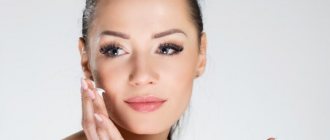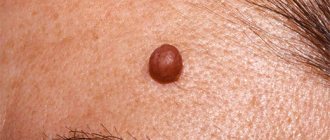Dexpanthenol is a substance derived from the water-soluble B vitamin - pantothenic acid. It is this that the body’s need increases when the skin and tissues are damaged. To compensate for the lack of substance and accelerate cell regeneration, use the topical drug D-Panthenol.
Compound
D-Panthenol ointment for external use - dexpanthenol, lanolin , phenonip, beeswax, white paraffin, emulsifier, dietetics, propylene glycol, butylated hydroxyanisole, decamethylcyclopentasiloxane, butylated hydroxytoluene, protegin B, magnesium sulfate heptahydrate, purified water. Cream D-Panthenol 5% for external use - dexpanthenol, cetearyl octanoate, ketomacrogol, methyl parahydroxybenzoate, cetanol, propylene glycol, dimethicone, glyceryl monostearate, propyl parahydroxybenzoate, purified water, flavoring.
Editorial conclusion
D-panthenol does its job well in treating children and adults. The drug in the form of an ointment can be called stronger, which means it can be used rationally for serious skin damage, burns, abrasions. The cream is an excellent preventative when there is a risk of chapping, frostbite, and sunburn.
The range of applications of D-panthenol is quite wide. It is used in pediatric practice and for the treatment of adults. The cream can be taken with you in windy and hot weather, and the ointment can be kept in the first aid kit for first aid and treatment in case of significant skin injury.
We concluded that D-panthenol cream is an excellent prophylactic agent, and the ointment can be used effectively for treatment. Do not forget that self-medication can be dangerous and you should always consult a doctor before starting to use the drug.
Pharmacodynamics and pharmacokinetics
Pharmacodynamics
Dexpanthenol is a derivative of pantothenic acid, which belongs to the B vitamins (water-soluble) that are part of coenzyme A. It plays an important role in metabolic processes: the breakdown of fatty acids, the release of energy from carbohydrates, the synthesis of sterols, acetylcholine, and steroid hormones. Pantothenic acid supports the functions of the epithelium, and in cases of damage to the skin or mucous membranes, there is an increased need for it. The drug stimulates the skin regeneration process, increases the strength of collagen fibers, normalizes cellular metabolism, and has a slight anti-inflammatory effect. Hydrophilicity, optimal molecular weight and low polarity of these drugs allow the active substance to penetrate into all layers of the skin. The auxiliary substances included in the ointment and cream improve the trophism of the skin and soften it.
Pharmacokinetics
The drug is quickly absorbed from the surface of the skin, and the active substance binds to blood proteins (albumin and beta globulin).
Indications for use
- various violations of the integrity of the skin formed under the influence of mechanical, temperature and chemical factors ( burns of various origins, bedsores , abrasions, scratches, superficial wounds, long-healing skin grafts);
- aseptic postoperative wounds after surgery;
- boils , dermatitis , inflammatory processes on the skin, trophic ulcers of the extremities, inflammation and cracked nipples in nursing mothers, lower skin care near tracheostomy , colostomy , gastrostomy ;
- in children - scratches, diaper dermatitis , irritation after ultraviolet radiation, for the prevention and treatment of diaper rash ;
- prevention and treatment of the consequences of exposure to various adverse environmental factors (humidity, wind, cold) on the skin.
Experts' opinion
E.S. Keshinyan and E.S. Sakharov, representatives of the Research Institute of Pediatrics named after. Yu. E. Veltishcheva, in the article “Experience of using Dexpanthenol”, made conclusions about the use of D-panthenol in different situations according to their observations.
Expert opinion on indications and contraindications for the use of D-panthenol:
- the product does not have an antimicrobial effect, so its use for inflammatory skin lesions is ineffective, which is especially true for the cream;
- in case of severe violations of the integrity of the skin, it makes sense to carry out initial pathogenetic treatment, after which D-panthenol can be used;
- the cream is more effective when used at the first signs of irritation and dryness, while the ointment is best used for existing damage;
- The cream can be used as a soothing and nourishing remedy for sunburn, frostbite, and dryness.
The cream works better as a prophylactic agent. It can be used on children after every bath and diaper change. Preventive use of ointment, according to the authors, is inappropriate. Moreover, it can be used from the appearance of the first signs of a disorder and until the symptoms completely disappear.
At the Center for Correction of Development of Young Children named after. Yu.V. Veltishchev studied the effectiveness of D-panthenol on 300 children aged from one month to 2 years. More than half of the patients in this group had prematurity and 22% of them suffered from atopic dermatitis of varying severity. It was found that with proper use of the ointment, its almost 100% effectiveness was achieved. In children, dryness, itching, and redness disappeared.
Instructions for use of D-Panthenol (Method and dosage)
D-Panthenol ointment, instructions for use: the ointment is applied externally in a thin layer to the skin in the affected area, lightly rubbing in, 2-4 (more often if necessary) times a day. If the skin area is infected, it is necessary to pre-treat it with an antiseptic. For breastfeeding women, lubricate the nipple with ointment after each feeding of the baby. Depanthenol ointment can also be used by children, including children under one year of age. For newborns, the ointment is applied after each water procedure or change of linen. The duration of use of the ointment is determined by the tolerability of the drug and the effectiveness of treatment.
Instructions for D-Panthenol cream: apply the cream externally to adults and children in a thin layer on the skin in the affected area, lightly rubbing in, 2–4 (more often if necessary) times a day, 2–4 times a day. If the skin area is infected, it is necessary to pre-treat it with an antiseptic. For nursing mothers who have cracked nipples, apply Depanthenol cream after each feeding of the baby. To treat damaged cervical mucosa and anal fissures and pathologies, it is enough to lubricate the affected areas 1-2 times a day.
It should be remembered that De-Panthenol ointment and cream are not recommended to be applied to weeping wounds. All forms of the drug are safe during pregnancy and lactation, both for the mother and the fetus.
What is better to choose
The cream and ointment contain a similar medicinal component and are used according to the same regimen and dosage. Their prices are also not much different. For shallow skin damage, it is better to use cream. It can be applied at any time of the day. When there are serious injuries, you should use an ointment that will affect the deeper layers.
The ointment is best suited for chapping, frostbite, and cracked nipples. For minor burns and scratches, you can use a convenient cream.
Analogs
Level 4 ATC code matches:
Panthenol
Kalanchoe juice
Aloe liniment
Levomekol
Pantestin-Darnitsa
Dexpanthenol
Contractubex
Pantoderm
Bepanten
Structural analogues by ATC code and active substance: Bepanthen ; Dexpanthenol ; Panthenol Pharmstandard; Korneregel ; Panthenol-ratiopharm ; Moreal-plus ; Panthenol ; Panthenolspray ; Pantoderm .
Reviews about D-Panthenol
Reviews about D-Panthenol ointment are overwhelmingly positive. “...I used D-Panthenol for acne yesterday. Today there is nothing left even to the touch, the skin is a pleasant color. I was even a little scared, maybe it was a hormonal drug. I used them before and the effect was good, but I was advised not to use hormonal drugs. I recommend". Many patients use De-Panthenol ointment for skin burns and note the high effectiveness of this form of the drug. But, nevertheless, for burns it is better to use depanthenol cream or D-Panthenol spray (correctly - Panthenol spray), which helps well with minor thermal and sunburns.
Reviews about D-Panthenol cream are also good. “...I first became acquainted with Depanthenol when I scalded my hand. The neighbor applied cream to the burn and three days later I didn’t even remember about the burn. The second time was when my hand was cut. I cut the bread poorly. And the cream also helped a lot. The healing took a little longer this time, but the result was good. Now depanthenol cream has taken its place in my home medicine cabinet.”
Many patients are interested in which form of the drug is more effective: “for what is it better to use ointment, and for what is it better to use cream?” The choice of the form of the medicine depends on the nature of the skin of the damaged surface: the ointment contains a higher percentage of fat and the use of depanthenol ointment is recommended for dry skin in the patient. The cream does not contain fat and the use of depanthenol cream is recommended on open areas of the body and on wet wounds. In addition, d panthenol cream is easily rubbed in and quickly absorbed, so it is recommended to use it for minor burns, in particular for sunburns.
Also, many patients are interested in D-Pantol suppositories, however, some of them mistakenly search for the drug using the query “depanthenol suppositories” and do not find this dosage form. You need to look for Depantol suppositories, not Depanthenol. This dosage form is widely used in gynecology. In addition to dexpanthenol, it contains chlorhexidine bigluconate, which has pronounced antimicrobial activity, as well as dermatophytes, yeast and protozoa. Has antimicrobial, regenerating and metabolic effects.
Often on the Internet, when discussing D-Panthenol ointment and what it is best used for, you can come across recommendations for using panthenol for hair. This is true, since Panthenol has an extremely beneficial effect on hair of any type, restoring damaged structure and nourishing it. Panthenol prevents fragility, dryness, splitting and splitting, increases the scalp's resistance to negative and damaging factors, eliminates itching, and stimulates hair growth. However, in this case, it is recommended not to use Panthenol spray, but to take the drug orally in the form of capsules (Panthenol-40), which is prescribed for hair loss, splitting and brittleness, dandruff, impaired hair growth, and increased production of sebaceous glands.
Patient reviews
Irina Zubova, 31 years old, Yekaterinburg: “D-Panthenol was recommended by doctors in the maternity hospital when my nipples became inflamed. But this medicine did not help. I got rid of the cracks only after being discharged from the hospital, using folk remedies. But the drug helped the child. I applied anti-diaper rash cream. A friend used Panthenol and also said that the drug was good for caring for a newborn, and also helped her eldest son with dermatitis. I'll take note."
Nina Kurilova, 27 years old, Orenburg: “I often use D-Panthenol. I apply it to my lips in winter when they are chapped, my hands and heels to prevent them from peeling. When your cheeks become chapped in the cold, this cream also helps. I once used the ointment after an unsuccessful peeling: in 4 days my skin returned to normal. And recently a friend said that Panthenol has the same properties, but is much cheaper. Next time I’ll try this cream.”
Olga Nikonova, 28 years old, Omsk: “I always try to have Panthenol cream or ointment in my home medicine cabinet. This is a drug for the whole family. I apply it to numerous abrasions and wounds on children. When we go to the sea, I definitely take it with me. The ointment stains clothes a little, but washes off well. The doctor recommended D-Panthenol, but the difference in price is so big, and the composition is identical, that I decided not to overpay.”
D-Panthenol price, where to buy
How much does De-Panthenol ointment cost in Russia and Ukraine? The price of Depanthenol ointment in Russia varies between 246 -375 rubles per package. The cost of the cream in a 30 g tube is, on average, 232 rubles per package. The spray in a 200 ml bottle can be purchased for 676 rubles. The price of D-Panthenol ointment in Ukraine is 246 UAH. The price of D-Panthenol cream is 278 hryvnia per package. You can buy Depanthenol cream in most pharmacies in Moscow and the pharmacy chain in Ukraine.
- Online pharmacies in RussiaRussia
- Online pharmacies in UkraineUkraine
ZdravCity
- Lengthening mascara with argan oil.
and D-panthenol black Belweder/Belvedere 10ml (A/TWA01)Belweder France RUR 399 order - D-Panthenol-Nizhpharm-Plus cream for external use. appl. tube 30 gAO "Nizhpharm"
RUB 292 order
- Antiseptic hand gel for children with D-panthenol Klinsa 60ml ZAO NPO Khimsintez
81 RUR order
- D-Panthenol ointment for external use. approx. 5% tube 25gOzon LLC
RUB 188 order
- D-Panthenol-Nizhpharm cream for external use. appl. 5% tube 25 gAO "Nizhpharm"
RUB 227 order
Pharmacy Dialogue
- D-panthenol-Nizhpharm cream (tube 50g)Nizhpharm JSC
RUB 336 order
- D-Panthenol Novatenol cream (tube 5% 50g) Jadran-Galenski
RUR 446 order
- D-Panthenol Novatenol cream (tube 5% 25g) Jadran-Galenski
RUB 257 order
- D-panthenol-Nizhpharm cream (tube 25g)Nizhpharm JSC
220 rub. order
- D-panthenol A-LAB moisturizing cream 5.5% 100mlRealCosmetics
RUB 399 order
show more
Pharmacy24
- Aqua Spray + D-Panthenol 45 ml spray PAT"Khimpharmzavod"Chervona Zirka",Kharkiv, Ukraine
69 UAH.order - “Children’s” with D-panthenol 100 ml cream OOO NPL Fitoprodukt, Ukraine
15 UAH order
- Aqua Spray + D-Panthenol 0.65% 150 ml nasal spray PAT"Khimpharmzavod"Chervona Zirka",Kharkiv, Ukraine
130 UAH order










